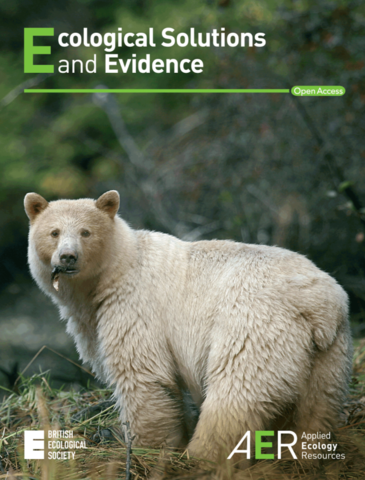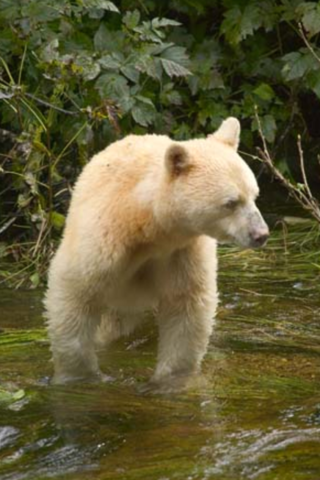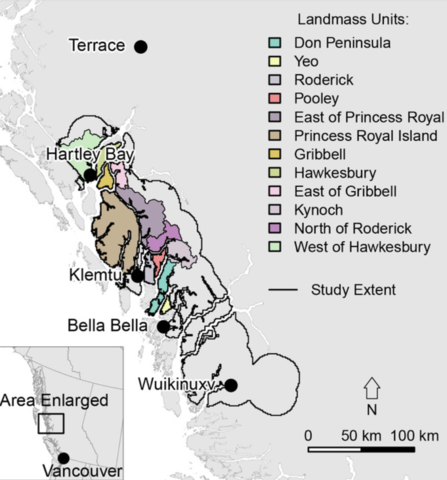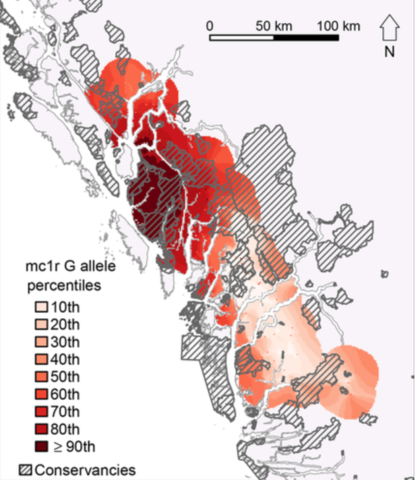Conservation Mysteries: The Kermode Bear
By Scott Nguyen and Ernesto Gonzalez, SciComm@UCR Undergraduate Mentees
Mentored by Erica Sarro, UCR Entomology

Ursus americanus kermodei, notably referred to as a “Kermode” or “Spirit bear” is a rare subspecies of white-coated black bear primarily seen within the Great Bear Rainforest, located alongside British Columbia’s northern and central coast. The exact nature of the bear’s unique coat and its biological role are unknown and remain just as mysterious as the Spirit Bear name entails. However, due to the lack of knowledge in the Kermode bear’s coat and its biological origins, the local indigenous community and the larger scientific community as a whole faced challenges in preserving this rare local subspecies amidst rising human development. With the need to protect irreplaceable ecological, cultural, and biological significance of the Kermode Bear in its habitat, a team of scientists conducted a study to survey and analyze the Kermode bear, to learn more about the gene that promotes its distinct white-coat appearance. Through working extensively with local Indigenous communities, the team was able to compile a significant sample size of hair samples over a vast, previously unsurveyed portion of British Columbia to provide direct comparison and new insights upon previous similar studies, in which it made new discoveries. Although much remains to be learned about the Kermode bear’s white-coat gene, this study displayed how biodiversity can intersect along local cultural, societal, ecological, and biological values. This is important because it is an increasingly present trend that species diversity is being threatened across the globe due to human development. Additionally, it provided new insights on how to non-invasively measure and track rare species that can be applied on a wider basis for other rare species. Overall, the team broke new ground in understanding the biology of the Kermode bear and has laid groundwork for further research into the mystery of the elusive Spirit Bear.
Imagine following a research team as they paddle along a pristine, clear river of a temperate forest in British Columbia. The environment is vibrant with brightly green vegetation and the immersive sounds of the forest surround the team as they make their way down the river. One cannot help but notice the excitement in the air; the team remains composed as not to cause a commotion.

Source:https://en.wikipedia.org/wiki/File:Spiritbear.jpg
The native tribes collaborating with the expedition informed the team that the animal the team is researching is an elusive creature with an almost ghost-like appearance. They describe how the animal is a figure shrouded in secrecy, as it is rarely seen and yet stands out as a respected figure in their folklore due to its distinct fur coat. As such, the team attempts to remain as quiet as possible as they venture further into the forest in search of this fabled animal.
As the team paddles to shore, the animals of the forest become the forefront of one’s attention. The crows let out caws overhead and salmon make their way through the river as the team sets up lenses and tripods to observe a particular section of the river. After a bit of time, one of the team members then notices something in the clearing. Amidst the brightly lit clearing, there is a haze of white that moves into focus and reveals itself to be a special white-coated bear in a lush green rainforest. However, this is not a polar bear, but rather a Spirit Bear.
The white-coated bear makes its way to the water’s edge where it slides in, and after a few moments, it snags a salmon right into its jaws. The team cannot help but watch in awe as the bear then fades into the forest just as suddenly as it had appeared in the clearing. The team would continue to document such findings within the area for the study on such a rare, enigmatic image of a white bear only found in that part of the world.
Though the experience of traveling through lush green forests and witnessing one of a kind animals is enough to get any nature enthusiast ecstatic, these researchers were not simply sight-seeing for leisure. Rather, this team had a specific objective in mind while exploring the Canadian wilderness: to find and track a particular bear variant contained exclusively in Canada's western region of British Columbia. The researchers specifically hoped to find the elusive white‐coated black bear variant (Ursus americanus kermodei), notably referred to as a “Kermode” or “Spirit bear”. The exact nature of where the bear is found and its biological role are as mysterious as the Spirit Bear name entails, a name given to it by the local Native American tribes. This spirit bear is a rare subspecies of black bear primarily seen within the Great Bear Rainforest, located alongside British Columbia’s northern and central coast. The bear is not its own species of bear, as in the case of a black bear compared to a brown bear, but rather a rare subspecies of the black bear (Ursus americanus). While the typical black bear is black in color, the Kermode bear is coated white due to a variation caused by having two of the same recessive genes (genes that only show their particular effect if there are no “dominant” genes to overtake them). The exact reasons why the white-color occurs and persists in the black bear population remain a guess, and there is a need to investigate how exactly it works. Thus, there lies an issue for scientists to resolve. The unknown nature of the Kermode bear’s white coat has presented obstacles to preserving it due to a lack of understanding. This lack of understanding persisting around the bear’s scarce presence and unique physical appearance prompted the Kermode bear to be chosen as a subject of scientific study. This bear represents the intersection of ecological, cultural, and biological relevance in the face of growing human presence in the area.
Firstly, there is the biologically significant reason to preserve the specific physical appearance and genetic build up of the Kermode bear. In the field of biology, genetic diversity within a species is important to maintain, as it allows species to have the flexibility to adapt to changes in their environment. If a species lacks diversity within its genes, it may fail to adapt to changes and its population may decrease to the point where it can affect the greater environment around it. While conventional conservation programs aim to preserve diversity by ensuring a variety of different genetic and physical types within a species, the opposite in safeguarding specific variants is being increasingly considered. This is because rare specific variants may have distinctive roles that they play in specific ways that allow them to uniquely adapt to ecological conditions like no other species can. For Kermode bears specifically, white bears attempting to capture salmon are 30 percent more successful than black bears during the daytime. This is most likely because from the perspective of fish in the river, the white bears blend in more with the sunlight above, much like how penguin bellies are white as seen below by fish. Though this seems to partially explain the presence of white bears, it does not explain why it shows up at such high frequencies (10 to 30 percent), for such a small edge. Regardless, investigating rare and localized variants like white fur can uncover unique environmental roles and pathways. These species can be used to better understand other rare species with similar situations.
Accompanying its biological uniqueness, the Kermode bear holds cultural significance in both the past traditions and current livelihoods of the Native American communities that reside in the British Columbia area. Within the Tsimshian language group’s culture, there is a story on how the creator of the world, the Raven, desired to have a memento of the Long White Time. Thus, Raven made a pact with Bear, the keeper of dreams and memory, that he could live in peace for all time if he agreed to have one out of every ten Black Bears turn white. This pact allowed Raven to have a reminder of the misery of the great ice age before the better world that was created and for Bear to live in the peace he desired. This folktale was passed down for generations through oral history and maintains a vibrant presence in Native tribes through traditional stories, dance, and songs. It serves as a testament to the respectful relationship the people have with the land and these unique bears.They are a living reminder of a more mystical past of man’s relationship with nature, untouched by modern civilization. In addition to its roots to cultural heritage, the Kermode bear is a source of income from which the Kitasoo/Xai'xais and Gitga'at Nations operate successful bear‐based ecotourism businesses (Lemelin, Koster, & Youroukos, 2015). These ecotourism businesses work to employ many of the native population in the area and fund campaign efforts against habitat modification, poaching, and other threats to the Kermode bear. Should the Kermode bear be harmed, both the cultural background and livelihoods of Native tribes in the area would be harmed as well.
Lastly, there is ecological importance at stake as the Kermode bear is subject to the ongoing threats of human development disrupting the local environment and the bear’s role within it. A specific human development that threatens to disrupt the environment and potentially devastate the Kermode Bear population is the proposed Enbridge Northern Gateway pipeline. This pipeline, proposed and contested before and during the study, would bring crude oil extracted from the Alberta tar sands up along the coast. If it were constructed, oil tankers would have to maneuver through tight channels such as the narrow, rocky, 100-mile-long Douglas Channel, and any incident or leakage would be unimaginably demerital to the local environment. As the white-coat gene and habitat role of the Kermode Bear remains unknown, any sudden change in environment would yield a wide range of unpredictable results. Due to needing to have two rare genes to produce the white coat, a fair amount of white coat genes circulating in the population is required to produce Kermode bears. Any sudden decline in population caused by human interference could disrupt this circulation and lower the amount of white-coat genes in the population. Should the amount decline low enough, there would not be enough white-coat genes to pass down naturally to produce Kermode bears as the more dominant black-coat gene became more frequent in the population pool. The end result would be the possible irreversible decline or almost complete disappearance of the rare gene capable of producing the white-coat appearance within the species. Thus, protecting the Kermode bear is an identifiable ecological concern, as it can be notably harmed by human development in its habitat.
Thus, the Kermode bear exemplifies the presence of an issue that spans biological, cultural, and ecological value, which foreign and native scientists alike needed to work together to resolve. The nature of the Kermode bear’s fur and how it is passed down within the bear population remains a mystery, which renders efforts to protect and understand Kermode bears, and other culturally significant native species like it, less effective in the face of human development. With the Kermode bear as the tangible poster species to champion research and conservation efforts, the native populace, Canadian government, and the research team put together a study to track and observe the Kermode bear. The study focused on investigating the population size of Kermode Bear, the biological nature of its fur coat, and the bear’s role in the environment, in order to better understand and protect the species.

Source: https://www.cbc.ca/radio/asithappens/as-it-happens-thursday-edition-1.5643649/b-c-s-revered-spirit-bear-is-rarer-than-anyone-thought-says-first-nations-led-study-1.5643652
In the pursuit to track and study the Kermode bear and its role within the British Columbia region, researchers collaborated with local institutions and indigneous tribes such as the Kitasoo/Xaixais,Gitga'at,Wuikinuxv First Nations. The team was granted sampling permission in the parks via an issued British Columbia Use permit, and the research was approved by the University of Victoria's Animal Care protocols and followed the Canadian Council for Animal Care's requirements for wildlife. As local cooperation with the indigneous people, the Kitasoo/Xaixais, Gitga’at, and Wuikinuxv First nations agreed to allow the researchers to document within their territories as well as provide assistance through local guides. In being provided proper legal channels and local access via indigenous tribes, the research team was able to survey the Kermode Bear’s presence beyond its previously documented range in past studies in the hopes to better understand the bear’s genetic and environmental role. The range of the study spanned roughly 6,600 km2 and covered a mix of sampled and not previously sampled areas, such as the First Nation territories, to gain a more holistic picture. With access to this greater range of research areas, the research team collected roughly 100-200 samples of hair per year during May and June each year from 2012–2017. They accomplished this study with methods inspired by local Native American strategies. Non-invasive hair snags, which were used to collect these hair samples, did not cause the bears any harm nor condition their behaviors to be reliant on humans, which was vital to showing the bears the appropriate respect between people and wildlife, as valued by the local First Nation tribes. Hair samples were collected every 10–14 days over two or three sampling times each year. These hair fibers could then be analyzed in a lab, where particular identifiers and traits like sex, coat color, and other physical and genetic differences can be recorded. The data was then analyzed to test particular theories on how and why the white-coat gene is maintained in the population. By the end of the data collection period, the team was able to compile a respectable sample size of hair data and sample area in which to analyze the genetic distribution of the Kermode Bears. All of this was facilitated by the support garnered by the local communities and access granted by local scientific and government institutions.

Source: 2020 - Ecological Solutions and Evidence - Wiley Online Library

Source: Spatial patterns and rarity of the white‐phased ‘Spirit bear’ allele reveal gaps in habitat protection - Service - 2020 - Ecological Solutions and Evidence - Wiley Online Library
These methods identified three major points of interest regarding conservation of the Kermode bear, those concerning the Kermode Bear’s gene presence, the kermode bear’s gene propagation, and the extent of what remains to be studied. Firstly, the studies noted that hotspots of white fur genes were present outside of established protected areas and that there was noted to be a lower frequency of the white coat gene than expected. This suggests that conservation efforts to preserve should be reevaluated in both the area and care provided as the Kermode bear might be in a graver state than previously noted. The next point of interest focused upon the continued presence of the gene within the black bear population. Previous studies noted the Kermode bear white coat individuals were caused by low genetic variance in the population. Much to the contrary, this study found observations to support the balance of white to black coat genes. This balance is consistent to a set ratio within recorded sites. This coincidentally agrees with the long standing Indigenous history of a consistent ‘1 in 10’ frequency for the white coat. The last point of interest was that despite the new breakthrough in Kermode Bear understanding and collaborative research, the observations made by this study yielded no definitive singular answer. The kermode bear’s mysterious nature remains an issue of conservation as its current state and vulnerabilities to human development are not yet fully understood. In conclusion, the study re-evaluated previous studies, but more importantly, laid the foundation for future studies to further investigate the white coat gene and how to best preserve it across biological, ecological, and sociocultural lines.
Although the study succeeded in elaborating upon the nature of the Kermode bear and the new questions that the scientific community has yet to answer, perhaps the most noteworthy achievement in this study was the collaboration. The study displayed notable consideration in working alongside local authorities and experts. The researchers cooperated with the local indigneous tribes such as the Kitasoo/Xaixais, Gitga'at, and Wuikinuxv First Nations to not only expand the range of previous studies, but also to aid in promotion of conservation efforts for the region’s eco-tourism and environmental interests against pipeline expansion efforts. From beginning to end, the collaboration between the larger scientific community and the local experts cooperated to mutually involve and benefit each party. Be it considering the local cultural and economic importance of the species or the larger scientific interest in the variant’s gene, the study displayed how conservation efforts in biodiversity can intersect along cultural, societal, ecological, and biological values. Thus, while the Kermode bear study may seem like a small collaborative effort with questions still unanswered, the manner in which it was conducted has set a respectful precedent for future collaborative research for Kermode bear and similar conservation efforts for rare, local species across the globe.
Sources:
- Service, Christina N., et al. "Spatial patterns and rarity of the white‐phased ‘Spirit bear’allele reveal gaps in habitat protection." Ecological Solutions and Evidence 1.2 (2020): e12014.
- https://evolution.berkeley.edu/evolibrary/article/0_0_0/conservation_04